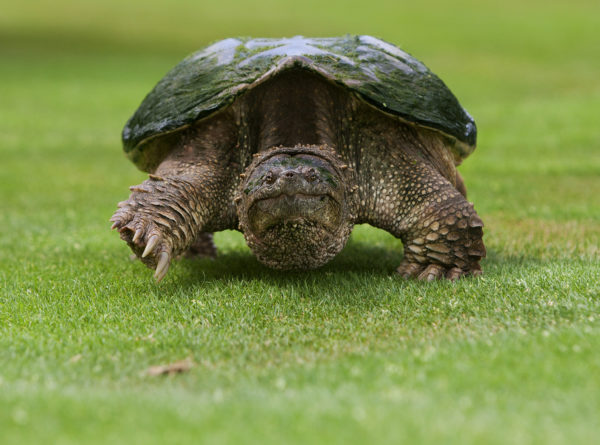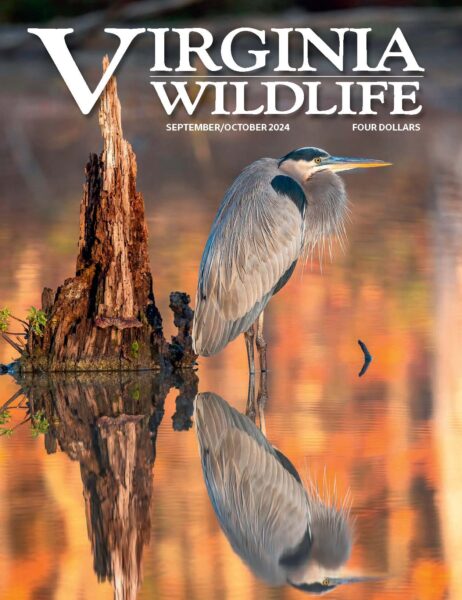
A common snapper paddles around the North Fork of the Shenandoah River. © Steven David Johnson.
By Jo Ann Abell
One day last fall, the dogs were raising a ruckus in our front yard. Their loud, insistent barking told me they had discovered something that, at least in their minds, didn’t belong there. Living in a very rural part of Rockbridge County in the foothills of the Blue Ridge, we have a lot of venomous snakes, and my fear was they had cornered a rattlesnake or copperhead, but as I got closer, I saw that it was a far less dangerous critter—a snapping turtle.
Unlike box turtles that can pull their head and legs inside their shell when confronted by a predator, the snapping turtle’s plastron (lower shell) is small, leaving much of their body exposed. On land, they make up for this lack of body armor with an aggressive temperament. When threatened, they raise their bodies and strike at an enemy with their jaws wide open. Although they have no teeth, their powerful jaws have a sharp cutting edge for biting and tearing apart prey. Their bite may not be venomous like a pit viper, but it can still be quite painful.
My husband, standing back a healthy distance, tapped the turtle’s beak with a stout stick. The snapper instantly took the bait, clamping down and latching onto it, and even when he pulled on the stick, this guy wasn’t letting go. With the business end of the snapper occupied, we were able to lift it onto a tarp, load it in a wagon, and move it a short distance to the creek in the front field where it, and the dogs, would be safe. We watched as it waddled away, continuing his (or her) journey.

The snapping turtle spends most of its time underwater only leaving to change locations, search for a mate, or lay eggs. © Steven David Johnson.
The snapping turtle, Chelydra serpentina, is the Commonwealth’s largest freshwater turtle, and the second largest freshwater turtle in the United States. A full-grown snapper can top over 50 pounds. The state record in Virginia is held by a 57-pound male with a carapace (shell) length of just over 18 inches.
This wide-ranging reptile is found throughout the eastern two-thirds of the United States and in southern and eastern Canada, which is the reason they also go by the moniker “common snapping turtle.” Snapping turtles are found all across the Commonwealth and on some barrier islands, where they live in a variety of aquatic habitats including ponds, lakes, streams, rivers, swamps, and brackish marshes. Areas providing cover in the form of stumps, muskrat lodges and burrows, overhanging ledges, and muddy bottoms are the most favored habitats.
They are active from late March through October, but snapping turtles can be found in water any month of the year. They’re most often seen in late spring when females search for nest sites, and in early fall, when hatchlings emerge from their eggs to negotiate terrestrial predators on their way to water.

After searching for a nesting site, this female snapping turtle lays a clutch of 25-55 eggs. © Joshua Gahagan, AKM Images, Inc.
Snappers are long-lived and slow to sexually mature. In Virginia, they don’t reach maturity until approximately 6 to 7 years of age. Female turtles lay a single clutch of 26–55 eggs annually on average. There is a high nest failure rate, with most of their eggs eaten by raccoons, crows, hawks, skunks, coyotes, dogs, foxes, and a host of other predators. Hatchling survival rate is only 6 to 9 percent in Virginia, but if they make it to adulthood, the rate of survivorship is high.
A Modern-Day Link to Dinosaurs
Today’s snapping turtles are related to Proganochelys, an ancient turtle that lived 215 million years ago. In comparison, the age of dinosaurs was approximately 150 million years ago, 100 million years after the earliest turtles. Proganochelys had most of the features of today’s turtles, including an armored shell formed from bony plates fused to its ribs and a semi-beak-like structure for gnawing plants. Additional plates around the bottom of the shell protected its legs. Turtles were one of the few reptile groups that survived the impact of a six-mile-wide asteroid that struck the Earth about 65 million years ago and the nuclear winter triggered by the event.
With their sharp beak and powerful jaws, stubby legs, sharp claws, and long Stegosaurus-like tail, snapping turtles have not changed much since dinosaurs walked the Earth. In fact, the modern-day turtle is a living fossil, having retained many of the features of the earliest turtles. Their well-designed body that has survived the ages gave them little need to evolve in order to survive. Equipped to inhabit all types of aquatic environments, they can live in the wild for 40 years or more.
These slow-moving creatures that spend most of their lives in the water have to be strategic to catch their next meal. To surprise their prey, they bury themselves in mud and lay in wait for their next meal to come along, then quickly strike and snatch it. Juvenile snappers eat insects, worms, snails, small fish, and aquatic vegetation. Adult snappers eat larger prey including insects, crayfish, fish, frogs, salamanders, tadpoles, toads, snakes, other turtles, young water birds, such as ducklings, and plant material. They also scavenge and clean up dead animals and fish. Despite their prehistoric, carnivorous-like appearance, aquatic plants make up to one-third of their diet, which they consume in massive amounts to support their large bodies.

Commercially harvested snapping turtles fill the bed of a pickup truck on their way to being dinner. © J.D. Kleopfer / DWR
Capable swimmers, snapping turtles are not aggressive in the water where they can easily evade predators. People have actually bumped or stepped on them in the water with little reaction. However, as I learned at an early age, they can be quite pugnacious on land where they are clumsy and slow, and, hence, more vulnerable. As a child, I ran across a young snapper on Theodore Roosevelt Island in Washington, DC. Thinking it was a box turtle, I picked it up. Within seconds, I watched in horror as it extended its head and long neck backwards over top of its shell, its large, open jaws reaching for my hand! My immediate reflex was to drop it, which is exactly what I did. After a moment to collect my thoughts, I was happy to see it waddle away, unhurt.
The Biggest Threat to Snapping Turtles is Man
While snapping turtles are the embodiment of turtles who shared the planet with dinosaurs for a time, they are now obliged to share it with the human species, a far bigger threat to its survival. Each year many females are hit by automobiles in their search for nesting sites, and hatchlings on their way back to the water are frequently run over. Often vehicles will not stop, and some drivers deliberately hit the turtles because they dislike snapping turtles or just enjoy running over them. Nests on roadsides and in gravel pits are often destroyed by vehicles and road grading.
Added to the gauntlet of obstacles snappers face, the species is a game animal in Virginia, and many are harvested each year for the food market. Increasing demand for turtle meat, both in this country and abroad, mainly China, presents a real and present threat to this species. In some states, snapper harvest season coincides with the egg-laying season, which hampers reproduction. Females are mostly shipped overseas to augment their aquaculture programs. Males are butchered, canned, and exported as processed meat.
Lack of meaningful regulations and overharvesting over the last decade has taken its toll on Virginia’s snapper population. In 2013, more than 125,000 pounds of snapping turtles were commercially harvested from Virginia’s waterways (actual harvest, including recreational collection, is likely higher). Based on annual permit reports, the 2013 harvest (7,926 turtles) almost doubled the 2012 harvest, and represents a nearly 1,300% increase in annual recorded harvests since 2002. High turtle prices, combined with tighter restrictions in neighboring states and weak regulations in the Commonwealth, have contributed to an increase in the number of commercial harvest permits sold to out-of-state watermen over the past 15 years.
From 2009 to 2013, out-of-state harvesters represented one quarter of the total number of permits issued, while responsible for as much as 70 percent of the annual harvest (approximately 360,000 pounds). As reported in the Richmond Times-Dispatch a few years ago, one of the harvesters that turned to Virginia’s waters when regulations were tightened in their home state was Tommy Fletcher of Rock Hall, Maryland. Having harvested about 22,000 pounds during the June-through-September season the previous year, Fletcher was quoted as saying, “I’d say you have plenty of snappers. How could I work away from home all summer year after year if the harvest wasn’t staying consistent?”
“There’s definitely a mentality that there are plenty of snapping turtles out there,” says J.D. Kleopfer, a herpetologist (reptile and amphibian expert) with the Virginia Department of Wildlife Resources (DWR), the state’s primary wildlife regulatory agency. Actually, local populations of the snapping turtle have declined significantly in recent years from overharvesting. Kleopfer points to other iconic and once-plentiful turtle species, like the Central American river turtle, the pig-nosed turtle, and the alligator snapping turtle, that have experienced steep population declines from overharvesting and are now at historically low levels across much of their ranges.
“We knew from looking at the snapping turtle harvest numbers that current harvest rates were unsustainable and that local populations were being decimated,” says Kleopfer. “We were also receiving a lot of complaints from Virginia harvesters and other concerned citizens about the number of turtles being taken by non- residents.” In response, the Department launched a multi-year study into the sustainability of Virginia’s commercial snapper harvest.

Due to new harvest regulations, snapping turtle populations are slowly recovering.
In 2013, researchers from Virginia Commonwealth University (VCU), with funding from DWR’s Nongame Fund and VCU, began a four-year study on the impact of commercial harvesting on snapping turtle populations in the state. “Team Snapper,” led by Benjamin Colteaux, Ph.D., with VCU’s Integrative Life Science program, spent many months catching and tagging turtles and collecting and recording indices of health and growth to determine the impact of wild turtle harvesting. In addition to the impact of commercial harvesting on the snapper population, the team also looked at the toxicology of the turtles, as these animals can show heightened levels of mercury depending upon age and location and are being exported into the human food market.
Based on study data, combined with information on harvest rates, survival probability, and reproductive output, the researchers could model population growth under various harvest pressure scenarios. According to their models, if harvest levels were reduced, the turtles, being naturally hardy creatures, would have a fighting chance. “Once they get to the adult stage, they are bullet proof,” Colteaux explained in an article in VCU News (October 25, 2017). “Their estimated rate of survival at that point is about 94 percent, but getting them to that point is really tough under current harvest conditions.”
The bottom line of the study was that current harvest levels were too high, especially in coastal waters. “Without better regulations placed on the industry, local populations of snapping turtles would have been seriously damaged, impacting both the sustainability of the industry and more importantly, the ecosystems in which these turtles live,” says Kleopfer. “Their impact as an apex predator in these aquatic systems is not fully understood, but we can look at other ecosystems where apex predators, such as wolves and sharks, have been removed or significantly reduced and see how ecosystem health declines as a result.”

Motoring across a golf course, this snapper becomes more vulnerable to injury, thus its aggressive behavior when on land. Would you mess with this old girl?
New Regulations in Effect for 2019
Armed with the science gained from the VCU study supporting a strong need to curb the decline on turtle populations, DWR adopted a series of new regulations that went into effect on March 1, 2019. The most significant changes included raising the minimum curved carapace length from 11 inches to 13 inches, restricting the number of harvesters, and limiting permits to Virginia residents only. Implementation of the new regulations will allow the continued harvesting of snapping turtles, while giving their populations time to recover and increase.
Like many other animals to which people have had little exposure, snapping turtles suffer from an image problem. Most people have heard exaggerated tales about the turtle’s irascible disposition. Take the claim, for instance, that they can break a broom handle in half in one bite, a claim proven to be false. While snappers have strong jaws and can bite, they lack teeth. Still, they will fight back if threatened—but it’s understandable that any animal that spends 95 percent of its life in water, where it is king of its domain, would feel vulnerable on land and would act to defend itself.
The Commonwealth’s snapping turtles are valuable to maintaining the ecological balance in the areas where they live. They are wonderful pond scavengers and garbage collectors that will eat any dead or dying fish and decomposed organic matter they come upon. Studies show that they don’t significantly impact fish or bird populations, mostly because they only prey upon diseased, weak, or very young animals.
Snapping turtles have been living in our North American wetlands almost unchanged for millions of years. Having witnessed the drift of continents, dramatic changes in climate, the birth of islands, and the rise and fall of mountain ranges, they are one of the greatest success stories in all of nature.

This article originally appeared in Virginia Wildlife Magazine.
For more information-packed articles and award-winning images, subscribe today!
Learn More & Subscribe







